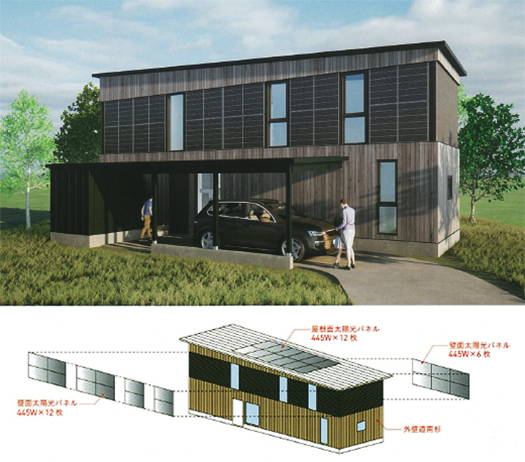

北海道の住宅施策で温暖地域とのいちばんの「条件」の違いとは積雪という風土条件。
住宅のエネルギーについて最初期の北海道住宅は、その開拓初期から豊富に採掘された「石炭」に依存した暖房を行ってきた。明治国家の北海道開発の過程にとって、石炭の発見はまさに奇跡のような出来事だった。ながく北海道島が日本国家として開発されてこなかったのには、日本住居に断熱という思想が皆無に等しかったことと、暖房エネルギー源が皆無だったことが大きかったのだ。
それが、開拓の思想において協力を受けたアメリカの技術者たちが夕張の近くで世界的にもきわめて埋蔵量の豊富な炭坑を発見してくれて、開拓のための「エネルギー源」を獲得できた。
日本の鉄道の開通が横浜ー東京間に引き続いて小樽(手宮)ー札幌間に走って、その最初の旅客として明治天皇が乗車されて札幌の地を巡られたことには、そういった経緯が表されている。明治天皇が札幌で宿泊された宿館も保存されている。
日本国家にとって石炭の発見・採掘は、北海道経営の突破口が開かれたと言えるのでしょう。
それと両輪で北海道住宅の暖房、居住環境の高度化、発展こそが明治国家以来の日本の宿願であり続けてきたと言えるのでしょう。そのことが侵略国家ロシアの南下の野望を粉砕し続けてきた最大の根拠。最近のウクライナ侵略という事態が、北海道に対して行われてこなかったのは、こうした北海道開拓の成功が大きな要因だったのだと、歴史的には言える。
まことに北海道の住宅技術とこのことは密接に結びついている。たぶん、日本史がもうちょっと進んで行ったら、このことは歴史に明記されていくに違いないと個人的には思っています。
そういう星霜を経て、今日、エネルギー問題はまた違った様相を見せている。
現代では太陽光発電・PVを活用することがひとつの方向性として確立してきている。このパネルの経年劣化後の廃棄についてどうするか、という問題は抱えつつも、大きな方向選択としては常識化した。
これは北海道にとっては非常に悩ましい。
積雪する屋根にはできれば「さわりたくない」のが普通のとらえ方。PVを載せてその積雪メンテはどうするか、という問題ですね。北海道の住宅諮問会議でもこのテーマが挙げられたとき「ついに迫られるのか」という空気感が漂っていた。そうした論議の中から「壁面設置」という具体案が盛り上がっていった。言うまでもなく屋根面設置に対してはエネルギー効率は低下するけれど、積雪への対応からは自由になる。あとは立地条件の確保などの要件になる。
今回、南幌での「ゼロカーボンヴィレッジ」ではそうした論議内容が反映したモデルプランが全プランから提示されていた。困難な気候条件の中で「最適解」を目指している努力の結果なのですね。
English version⬇
Hokkaido Style: Using PV for Zero-Energy Homes
Struggle for advanced insulation. Although the operating rate is generally less than 70% for roof-mounted PV, we are moving toward a concrete approach to PV “wall-mounted” installation. …
The most important difference between Hokkaido and warmer regions in terms of housing policy is the endemic condition of snowfall.
Regarding energy for housing, the first houses in Hokkaido were heated by coal, which was mined in abundance from the early stages of development. The discovery of coal was a miracle for the development of Hokkaido in the Meiji era. The reason why Hokkaido Island has not been developed as a Japanese nation for so long is largely due to the fact that there was no concept of insulation in Japanese housing and no source of heating energy.
However, American engineers, with the help of pioneering ideas, discovered a coal mine near Yubari that had extremely abundant coal reserves on a global scale, and this provided an “energy source” for the pioneering work.
The opening of Japan’s railroad line between Otaru (Temiya) and Sapporo, following the line between Yokohama and Tokyo, and the fact that the first passenger on the line was the Emperor Meiji, who toured the area of Sapporo, is an indication of this. The inn where the Emperor Meiji stayed in Sapporo has been preserved.
For the Japanese nation, the discovery and mining of coal may be said to have marked a breakthrough in Hokkaido management.
It can also be said that the heating of houses in Hokkaido and the advancement and development of the living environment have been Japan’s long-cherished aspiration since the Meiji era. This is the biggest reason why Japan has continued to crush the southward ambitions of Russia, the aggressor nation. It can be said historically that the reason why the recent invasion of Ukraine has not been carried out against Hokkaido was largely due to the success of such Hokkaido development.
Indeed, Hokkaido’s housing technology is inextricably linked to this. I personally believe that when the history of Japan progresses a little further, this will be clearly stated in history.
After such a star-studded history, today, the energy issue has taken on a different aspect.
Today, the use of photovoltaic or PV power generation has been established as one direction. While we still have the problem of what to do about the disposal of these panels after they deteriorate over time, it has become common sense as a major directional choice.
This is very troubling for Hokkaido.
The question is how to maintain the snow-covered roof with PV panels on it. When this topic was raised at the Hokkaido Housing Advisory Council meeting, there was a sense of “are we finally being forced to do something about it? It was from such discussions that the specific idea of “wall installation” gained momentum. Needless to say, energy efficiency would be lower than roof-mounted systems, but the system would be free from the need to deal with snow accumulation. The other requirements are location and other conditions.
The “Zero Carbon Village” in Minamihoro this time presented a model plan reflecting such discussions. It is the result of efforts to achieve this kind of “optimal solution” in difficult climatic conditions.
Posted on 3月 14th, 2024 by 三木 奎吾
Filed under: 住宅マーケティング







コメントを投稿
「※誹謗中傷や、悪意のある書き込み、営利目的などのコメントを防ぐために、投稿された全てのコメントは一時的に保留されますのでご了承ください。」
You must be logged in to post a comment.